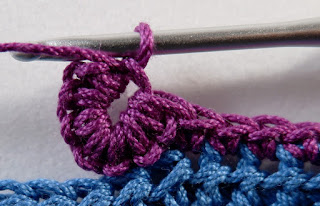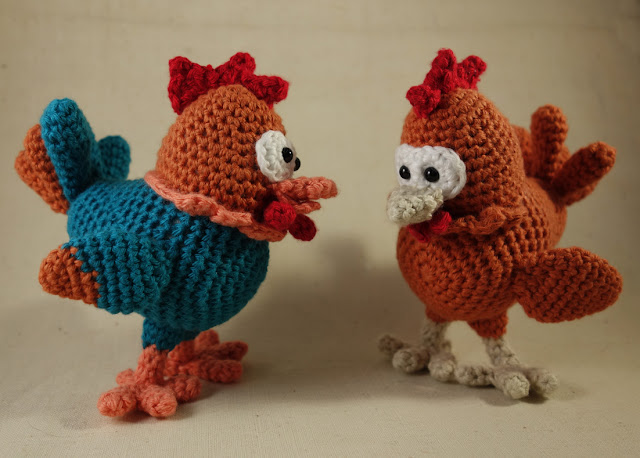*Dc in next stitch, 1 Tatted picot, skip2 stitches, Dc in next stitch. Dc in next 4 stitches**.
Search This Blog
Tuesday 15 December 2020
Tatted Picots and Half-Hitches.
*Dc in next stitch, 1 Tatted picot, skip2 stitches, Dc in next stitch. Dc in next 4 stitches**.
Tuesday 17 November 2020
Crocheted Birds
At this point I admitted that I had an ornithological leaning and invested in Vanessa Mooncie's Crocheted Birds book. If you've read my Crochet Sea Creatures blog post or made any of Vanessa's patterns then you'll know that she has a true understanding of three dimensional shapes.The structure is created mainly using arcs which intersect to produce very organic shapes. Sometimes I was working in the round and sometimes in rows. Not only does this help to create the form but also to suggest feathers.
The final element is the embroidery. Once again my crochet skills are far in advance of my sewing ability. I don't think it is unusual for a knitter or crochet to baulk at this moment. As I wasn't exactly following the instructions to the letter, I did quite a lot of experimenting and procrastinating at this point!I found that after all that procrastinating the wings were looking a little battered. As a finishing touch I used some spray starch on the wings which was allowed to dry before I attached them.
Tuesday 20 October 2020
How to make Flat X and Y Crochet Stitches
We all have a comfort zone, a safe place were there are no unexpected challenges and no frustration. Stepping outside that place is a little scary, it means taking a risk, but brings unexpected rewards. Finally I have challenged myself with the X and Y stitch and been happily surprised by the result!
Whenever I've looked at the instructions for an X or Y stitch, all I've seen is YarnOverYarnOverYarnOver and immediately a little voice inside my head starts screaming! Finally I have fought my way through those seemingly undulating instructions. I've figured out exactly where that hook should go. Let me try to demystify it for you and serve it up in a slightly more palatable fashion.[In all these examples I've chosen to place a Chain1 between the crossed stitches for visual clarity.]
Let's start by looking at the sort of crossed stitches that we're all familiar with. Shall we call them 'unconnected X stitches'? You know, where the diagonals can travel in front or behind each other and are completely independent of each other. They can be made using any number of diagonals crossing each other.
If the foremost stitch slants down to the right, then the second stitch needs to be made in front of the first. This is a little bit more fiddly.
The next type we could call 'connected X stitches'.
That's when the second diagonal encloses the first like a spike stitch. This is usually made with a Treble (Dc-USA). In this case the working yarn should be held behind and the stitch made in front, encapsulating that first diagonal.There is a second way of making this with a taller stitch. Let's call it a 'parallel X stitch'.
It's possible to use this same wrapping technique to make a 'Y' stitch.
Wouldn't it be great, just for once, to say it was all that simple? Sadly this is ThePulledStitch universe where nothing can EVER be quite that simple! So before I leave you I have to offer you one more flat X stitch version.
In a chart it would probably look like this:
And is made as follows:I can't decide which of these two flat X stitches I prefer. I shall leave you to decide! The truth is always 'there is no right or wrong in crochet'. You will find that there are as many ways to make these stitches as there are grains of sand on a beach. You will find fat X's and thin X's, tall Y's and short Y's.
Hopefully neither of us will ever be scared of tackling one again and if you don't like the way it looks, you'll understand how to change it to one you do like.
Fastening Off...
Tuesday 22 September 2020
Birds Nest Table Mat
I have a pattern and tutorial for you this month which came about by accident. It is derived from one of those old family patterns that has been passed down, but never written down. So you may well recognise the technique. It reminds us that no matter how clever or innovative we think we are, we are merely riding the shoulders of giants.
I found the original on the 'Miss Abigail's Hope Chest' blog where it had been artfully translated for us. I thoroughly recommend the blog and urge you to raise your hook in salute of the author, Kathleen Mower and her amazing Hope-Chest achievement.
As often happens when something lights a fire in our creativity, I was thinking about something else entirely, but I was so fascinated by Kathleen's pattern for a Hot Pad that I just had to try it. The amazing thing about the technique is that it creates a double thickness fabric. Here is my attempt in Double Crochet (Sc-USA).
I was so delighted with the result that I just couldn't help wondering if I could work the same thing using Half-Trebles (Hdc-USA).
So what about Trebles? (Dc-USA)
Well one thing just has to lead to another! I decided to try to work it in a circle in Trebles (Dc-USA). Ah! Now this wasn't quite as simple as I was hoping.
Let me start by showing you how the Square Hot Pad works up in Trebles (Dc-USA).
Start with 27 chain stitches, Treble (Dc-USA) in 3rd chain from the hook, Treble in each stitch to the end, turn. [25Trebles, Ch2 does not count as stitch here and through out.]and repeat in each pair of treble/chain stitches to the end, turn. [25BLTr]
For final row: Chain1, Double crochet (Sc-USA) through both loops of first upper row stitch and back-loop of first lower-row stitch simultaneously. Repeat in each pair of upper/lower row stitches to end. Fasten off. [25Dc]
This version made with Scheepjes Bloom, 100% cotton yarn, turned into a useful wash cloth.
As you have seen, we are overlapping our rounds and creating a double layered fabric. To make a circular design we have to place the stitches simultaneously into two rounds with two different stitch counts. So let me demonstrate how this works in practice.
I'm starting with a double magic ring. Having finally mastered this, (which let's face it wasn't that hard after all) I think it gives greater stability to the centre of our mat. I demonstrated the technique in last months blog post. Round One starts with a starting-chain and is simply 8 double crochet stitches (Sc-USA) into that ring.
At the end of each round we need to slip stitch to the first stitch and then turn. Yes, I said turn! It's not something we are use to doing when making a flat circle, is it?
For Round Two we make 2 back loop trebles (Dc-USA) into each stitch. However instead of beginning the round with starting chain stitches we simply pull up a tall loop and go straight into making the first treble. The loop creates the 'head' of the first treble stitch. I've chosen to do this in order to disguise the join.Once again we join the round with a slip stitch, this time placing the slip stitch into the 'Starting Loop'. The Starting Loop is also going to be the last stitch in the round, it is easy to miss so I am going to ask you to place a stitch marker in it. And turn.Round Three is the most complicated round in the whole pattern. After this the rest will feel like plain sailing. Looking at your mat so far, you will see that Round1 has 8 back-loops left open and Round2 has 16 stitches. We are going to be placing the stitches into the two rounds simultaneously. At the end of this round we need to have added extra 8 stitches. (16+8=24). This means we have to fit 24 stitches into the 8 stitches of Round1. This is why the instructions look a little crazy.
Let's start simply, after pulling up a Starting Loop, we make the first Treble by placing the hook in the back loops of the first stitch of round2 and round1 together. I'm calling this a Special-Back-Loop Treble.Now we need to put 2 more stitches into that round1 back loop that we've already used. So we make 2 Special-Back-Loop Trebles, placing the hook through the next round2 stitch but the first round1 stitch.That's it, those three stitches are the repeat. Finish the round by slip stitching to the start, placing the stitch marker in the Staring Loop and turn.Round Four. Looking at your mat now, you will see that Round2 has 16 back-loops left open and Round3 has 24 stitches. (In the pattern I give you a stitch count for both rows.)
The round begins by pulling up a Starting Loop and making a Special-Back-Loop Treble in the first stitches of round3 and round2 at the same time. The next Special-Back-Loop Treble goes into the next round3 stitch but the same round2 stitch that already contains a stitch. Now we make 2 Special-Back-Loop Trebles into the next stitch of round3 and the next stitch of round2.So this time those four stitches create our repeat sequence. And at the end of the round the stitch count is 32 and 24.In the pattern I have given you the full written instructions for the first five rounds, but then I've given the instructions in a table format. I think you will find this easier to follow. I've also included a little chart for each round. This gives you a thumbnail sketch of each pattern repeat.For the final Double Crochet (Sc-USA) round I've given two sets of instructions in the pattern. I'm enabling you to make a coaster sized mat and a plate sized mat.
Did you spot my claim that I make colourful customisable crochet? I almost never follow a pattern verbatim. There is just something in my nature that won't allow me to! So I never expect you to either. This means I expect you to make your mats in whatever yarn and to whatever size you feel like. You rebel! I have therefore given you further guidance on how to make that final round. Should you wish to go larger than my instructions allow, I think you will quickly see there is a pattern emerging in the numbers. You won't have to do any maths I promise! Should you run into any problems then email me! I will not take offence and I will reply.😇
I loved the yarn that Kathleen used for her Hot Pad. I chose the Rico Essentials version. The colour made me think of birds' eggs, hence the pattern's name. I wanted to use more than one colour but I realised that a long colour changing yarn might emphasis the end of each round, so this yarn seemed like an ideal fit. However the flecks also help to disguise the stitches. So if you would like to work your mats in a similar yarn, please practice the first four rounds in a plain colour yarn first.
Here is the downloadable PDF pattern link! Go create!







































































